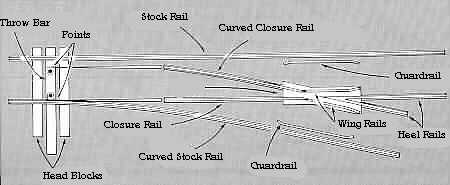TurnOuts
Turnouts
If your railroad doesn't have turnouts, then operation is quite limited. You
can't have industrial yards, crossovers, spurs, or any other trackage that involves switching from one to another. You can only watch it go round and
round. There are many types of turnouts or switches which will improve excitement of operation. However, you have to
take the bad with the good, because chances of derailment and other problems are greatest at the turnouts. Turnouts are classified by number
based on the ratio of the spread to the length of the frog. The angle between
the two heel rails is the determining factor. A number four turnout is larger than a number six. And the larger number means a sharper turn and less
space needed for the switch. For example: An atlas number six takes twelve inches of layout space and a four and a half takes nine inches. If you have
enough space, use six, eight or higher turnouts. Sharper turnouts will reduce the size of car you can run. In order to have less problems at your turnout
point, make sure that the base is solid. If you have any bumps or inclines close to the turnout it could cause distortion of railheads, which may affect
point alignment and make your train derail. When installing the turnout use
as few spikes as possible, the less spikes you use gives less chances of
spreading the rails out of gauge. When driving the nails, always leave space between the nail head and the tie, this allows the turnout to float above the
supporting surface. This does not force the track out of level and allows for easy changing.
Be careful if ballists turnouts, it is easy to ballist to interfere with the points,
the throw rod, or the frog. Ballists should not be above tie level.
Often check to make sure turnouts work properly, dusting away any dirt that
may lodge between the points. The points should always be sharp. Blunt
points cause cars to bump into the end and rollover, causing derailment. Also, make sure the points remain level with the rails. Finally, make sure
the rails are clean to insure good electrical contact. This applies to the inside
of the points particularly when they conduct electricity to the branching
track. Clean point sides with fine sand paper folded in half.
Hope the info helps, look for other sections in upcoming months !!!
RETURN
Copyright ©1995-2004 HobbyLinc. All rights reserved. Images and Descriptions are representative only, actual items may vary. Prices subject to change without notice.

